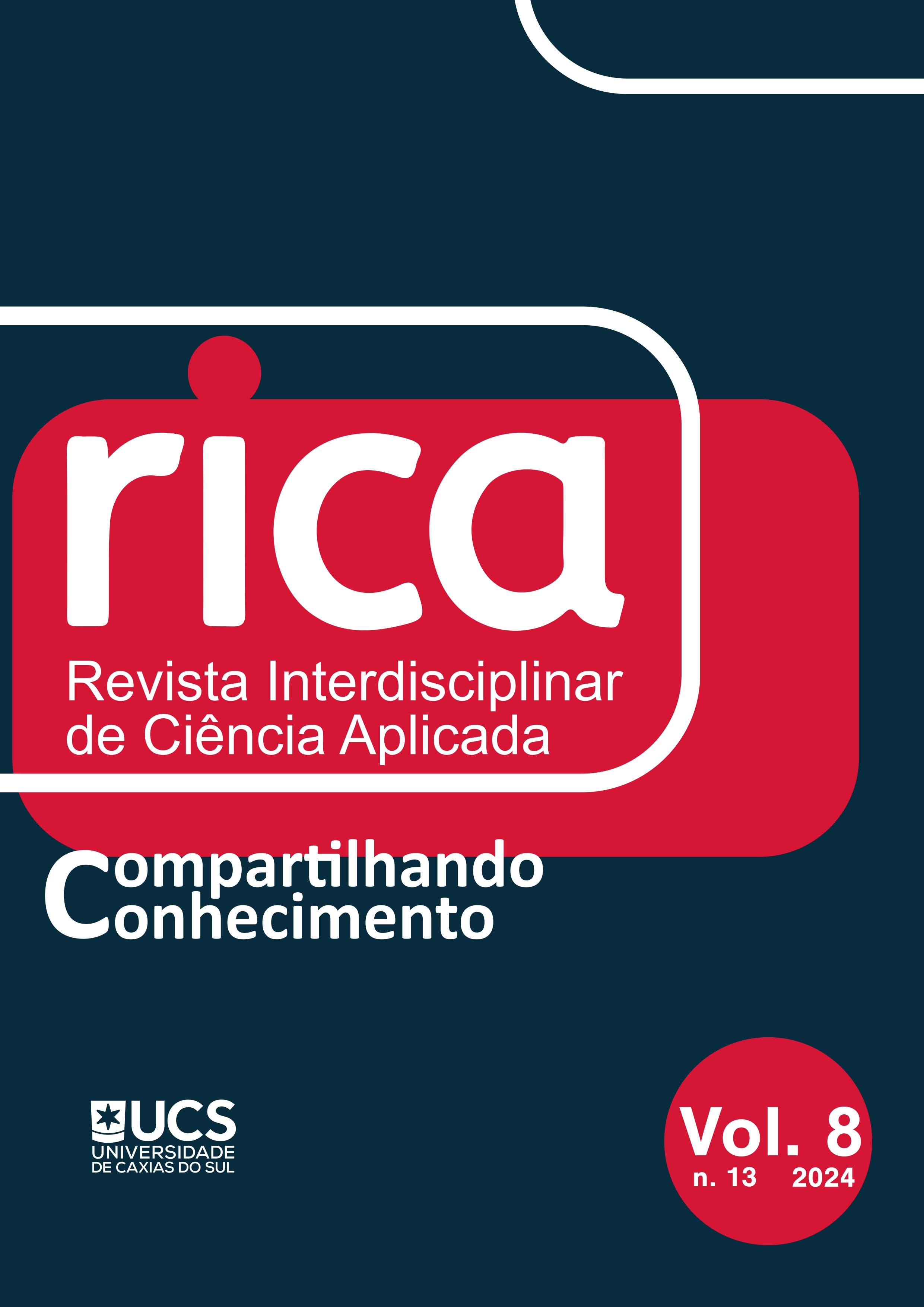Um potential diagnostic and prognostic biomarker in gastric cancer: an in silico analysis of the GPNMB gene
DOI:
https://doi.org/10.18226/25253824.v8.n13.13Keywords:
Stomach cancer, Differential expression, Artificial intelligence, Gene Expression Omnibus, The Cancer Genome AtlasAbstract
Gastric cancer is the fourth most common and third deadliest cancer worldwide. Patients are usually asymptomatic or do not show specific symptoms during initial stages, which may hamper the diagnosis. A previous study identified 39 genes with biomarker potential in gastric cancer, among them the GPNMB gene. In this context, the objective of this study was to explore GPNMB as a prognostic and diagnostic biomarker for gastric cancer. Expression data was extracted from Gene Expression Omnibus (GSE33335 and GSE54129) and The Cancer Genome Atlas (TCGA-STAD). Data acquisition, preprocessing and statistical analyses were performed with an inhouse developed tool. The K-means and decision tree algorithms were applied for determining the potential of the gene as a diagnostic biomarker, whereas the survival analysis verified the influence of expression on prognosis. GPNMB expression was higher in tumoral tissue samples when compared to non-tumoral adjacent tissue (NT). K-means allowed formation of independent groups with normal and NT samples. Similarly, samples were correctly classified into normal and NT tissue groups with the decision tree according to expression values. Additionally, the survival analyses showed that the high expression of the GPNMB gene is associated with a worse prognosis. This research provided evidence on the potential of GPNMB as a biomarker for gastric cancer, given the gene demonstrated an important role in disease development.
References
de Araújo, N. D., de Farias, R. P., Pereira, P. B., de Figueirêdo, F. M., de Morais, A. M. B., Saldanha, L. C., & Gabriel, J. E. (2008). A era da bioinformática: seu potencial e suas implicações para as ciências da saúde. Estudos de biologia, 30(70/72): 143-8 https://doi.org/10.7213/reb.v30i70/72.22819
INSTITUTO Nacional de Câncer (INCA). O que é câncer? Disponível em <https://www.gov.br/inca/pt-br/assuntos/cancer/o-que-e-cancer>. Acesso em: 21 set. 2022.
Vogelstein, B., & Kinzler, K. W. (2015). The path to cancer—three strikes and you’re out. N Engl J Med, 373 (20), 1895-1898. https://www.nejm.org/doi/10.1056/NEJMp1508811
Ward, L. S. (2002). Entendendo o processo molecular da tumorigênese. Arquivos Brasileiros de Endocrinologia & Metabologia, 46, 351-360. https://doi.org/10.1590/S0004-27302002000400006
Bray, F., Ferlay, J., Soerjomataram, I., Siegel, R. L., Torre, L. A., & Jemal, A. (2018). Global cancer statistics 2018: GLOBOCAN estimates of incidence and mortality worldwide for 36 cancers in 185 countries. CA: a cancer journal for clinicians, 68 (6), 394-424. https://doi.org/10.3322/caac.21492
Yakirevich, E., & Resnick, M. B. (2013). Pathology of gastric cancer and its precursor lesions. Gastroenterology Clinics, 42 (2), 261-284. https://doi.org/10.1016/j.gtc.2013.01.004
Van Cutsem, E., Sagaert, X., Topal, B., Haustermans, K., & Prenen, H. (2016). Gastric cancer. The Lancet, 388 (10060), 2654-2664. http://dx.doi.org/10.1016/S0140-6736(16)30354-3
Pasechnikov, V., Chukov, S., Fedorov, E., Kikuste, I., & Leja, M. (2014). Gastric cancer: prevention, screening and early diagnosis. World journal of gastroenterology: WJG, 20 (38), 13842. http://dx.doi.org/10.3748/wjg.v20.i38.13842
Lee, J. Y., Kim, H. I., Kim, Y. N., Hong, J. H., Alshomimi, S., An, J. Y., ... & Kim, C. B. (2016). Clinical significance of the prognostic nutritional index for predicting short-and long-term surgical outcomes after gastrectomy: a retrospective analysis of 7781 gastric cancer patients. Medicine, 95 (18), e3539. https://doi.org/10.1097/md.0000000000003539
Matsuoka, T., & Yashiro, M. (2018). Biomarkers of gastric cancer: Current topics and future perspective. World journal of gastroenterology, 24 (26), 2818. https://doi.org/10.3748%2Fwjg.v24.i26.2818
Henry, N. L., & Hayes, D. F. (2012). Cancer biomarkers. Molecular oncology, 6 (2), 140-146. https://doi.org/10.1016/j.molonc.2012.01.010
Rossetto, M. V. (2019). Análise de expressão diferencial de genes: uma solução computacional para identificação de biomarcadores de tumores gástricos em humanos. Dissertação, Universidade de Caxias do Sul https://repositorio.ucs.br/11338/8780
Taya, M., & Hammes, S. R. (2018). Glycoprotein non-metastatic melanoma protein B (GPNMB) and cancer: a novel potential therapeutic target. Steroids, 133, 102-107. https://doi.org/10.1016/j.steroids.2017.10.013
Edgar, R., Domrachev, M., & Lash, A. E. (2002). Gene Expression Omnibus: NCBI gene expression and hybridization array data repository. Nucleic acids research, 30 (1), 207-210. https://doi.org/10.1093/nar/30.1.207
Cheng, L., Yang, S., Yang, Y., Zhang, W., Xiao, H., Gao, H., ... & Zhang, Q. (2012). Global gene expression and functional network analysis of gastric cancer identify extended pathway maps and GPRC5A as a potential biomarker. Cancer letters, 326(1), 105-113. https://doi.org/10.1016/j.canlet.2012.07.031
Cancer Genome Atlas Research Network. Comprehensive molecular characterization of gastric adenocarcinoma. Nature 513, 202-209, 2014.
Demšar, J., Curk, T., Erjavec, A., Gorup, Č., Hočevar, T., Milutinovič, M., ... & Zupan, B. (2013). Orange: data mining toolbox in Python. the Journal of machine Learning research, 14 (1), 2349-2353. https://www.jmlr.org/papers/volume14/demsar13a/demsar13a.pdf
Lazaratos, A. M., Annis, M. G., & Siegel, P. M. (2022). GPNMB: a potent inducer of immunosuppression in cancer. Oncogene, 41 (41), 4573-4590. https://doi.org/10.1038/s41388-022-02443-2
Li, H., Xiao, Y., Wu, C. C., Yang, L. L., Cao, L. Y., Chen, D. R., ... & Sun, Z. J. (2019). High expression of GPNMB predicts poor prognosis in head and neck squamous cell carcinoma. Histology and Histopathology, 34(7). https://doi.org/10.14670/hh-18-084
Ren, F., Zhao, Q., Liu, B., Sun, X., Tang, Y., Huang, H., ... & Mi, Y. (2020). Transcriptome analysis reveals GPNMB as a potential therapeutic target for gastric cancer. Journal of Cellular Physiology, 235(3), 2738-2752. https://doi.org/10.1002/jcp.29177
Huang, Y. H., Chu, P. Y., Chen, J. L., Huang, C. T., Huang, C. C., Tsai, Y. F., ... & Liu, C. Y. (2021). Expression pattern and prognostic impact of glycoprotein non-metastatic B (GPNMB) in triple-negative breast cancer. Scientific reports, 11 (1), 12171. https://doi.org/10.1038/s41598-021-91588-3
Maric, G., Rose, A. A., Annis, M. G., & Siegel, P. M. (2013). Glycoprotein non-metastatic b (GPNMB): A metastatic mediator and emerging therapeutic target in cancer. OncoTargets and therapy, 9 (6) 839-852. https://doi.org/10.2147/OTT.S44906
Downloads
Published
How to Cite
Issue
Section
License
Copyright (c) 2025 Lopes et al.

This work is licensed under a Creative Commons Attribution 4.0 International License.
Authors keep the copyright and cede to the journal the right of publishing first. Published works are licensed under a Creative Commons Attribution 4.0 International (CC BY 4.0) license, allowing the sharing of the work with recognition of the authorship and initial publication in this journal.






